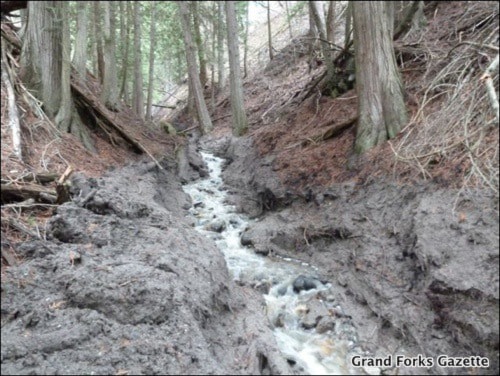The Forest Practices Board (FPB) has released its report on a mudslide that occurred in the Gilpin Grasslands in spring of 2011.
The Gilpin Creek Debris Slide report found that the fences were not wildlife friendly as set by the Ministry of Environment’s criteria, and that modifications may be necessary.
As well, the report noted that the design and placement of a water trough appears to be reasonable.
The ranchers, the Mehmal family, were found not guilty and have modified the trough to avoid accidental connection of the intake pipes that run from a small dam to the trough.
Barry Brandow Sr., a long-time guide outfitter, made the complaint when he noticed the mudslide above Gilpin Creek, on the Overton-Moody Range Unit near Grand Forks.
The water trough was released onto an unstable slope and the ground became saturated, causing a debris slide that resulted in a significant amount of soil entering Gilpin Creek.
Brandow pointed out to the FPB that the location and operation of the trough was not in a proper place, and that the fencing that prevents the cattle from access to the creek was not wildlife friendly.
But Brandow was not happy with the results.
“I’m disgusted by the report,” he said. “Who decided that the rancher was not guilty and what evidence did they have?”
He pointed out the incident in Walkerton, Ont. with residents becoming sick due to drinking water contaminated with the E. Coli (Escherichia coli).
E. Coli is bacteria found in the lower-intestines of warm-blooded organisms. Though most strains are harmless, the bacteria has been known to cause diarrhea, kidney failure and possibly death.
The incident in Walkerton occurred due to farm runoff into an adjacent well, causing many residents to become sick and at least seven people died directly from drinking the contaminated water.
“We still allow cows access to creeks and streams,” Brandow said. “What should be done is put up proper fencing, which wasn’t done. It should have been a well co-ordinated event with all the stakeholders, as it is it’s just talking right now so nothing is getting done.”
Karen Mehmal, the rancher and one of the owners, disagrees and stated that prior to putting the fence in, they had consulted with the Ministry of Forests, Ministry of Environment, BC Parks, Interfor and First Nations.
“We consulted with everybody and informed them about our proposals before we even began,” she said. “We looked at the straight wire because we’re only fencing small areas. It doesn’t impact the migratory routes and what it does and is intended to do is to keep the cattle out of riparian zones.”
In the report, the FPB noted the fence was contrary to wildlife friendly fences.
Board Chair Al Gorley of the Forest Practices Board recommended to the Ministry of Environment that the fence be looked at to decide what changes may be necessary to make it more wildlife friendly.
Gorley stated there are a variety of modifications that could be considered.
“If changes are required, it will be up to the Ministry of Forests, Lands and Natural Resource Operations (MFLNRO) to decide whether MFLNRO or the rancher is responsible to implement them,” he added.
Gorley pointed out that the Mehmals have made modifications to the connections to make it more difficult to connect the intake hose.
“Whether further modifications are necessary to manage possible future spills will be the responsibility of the Ministry of Forests, Lands and Natural Resource Operations to decide,” Gorley concluded. “They are still conducting an investigation into the slide.”
Mehmal noted that if smooth wires were put up, the cattle would just walk into the riparian areas.
“The idea of the fence is to keep the riparian area from the cattle. We consulted with the Ministry of Environment initially, and they felt in this circumstance we didn’t choose a smooth wire because it doesn’t interfere with migratory routes,” she stated.
But Mehmal agreed that changes might occur should the Ministry of Environment suggest alterations.
Mehmal stated that there was a lot of moisture last year and there were mudslides occurring in many locations.
“I think that the report found that, but it did bring to our attention that somebody had gone back after we had dismantled the water trough and put it back in so that water would run through the hose,” she explained. “Fortunately there wasn’t a lot of water so it didn’t cause any damage but it was definitely malicious in nature.”
However, Brandow said that residents want accountability.
“It’s our land and our water, we want to take care of it,” he concluded.
